Last Updated on 6 May 2024 by Cycloscope
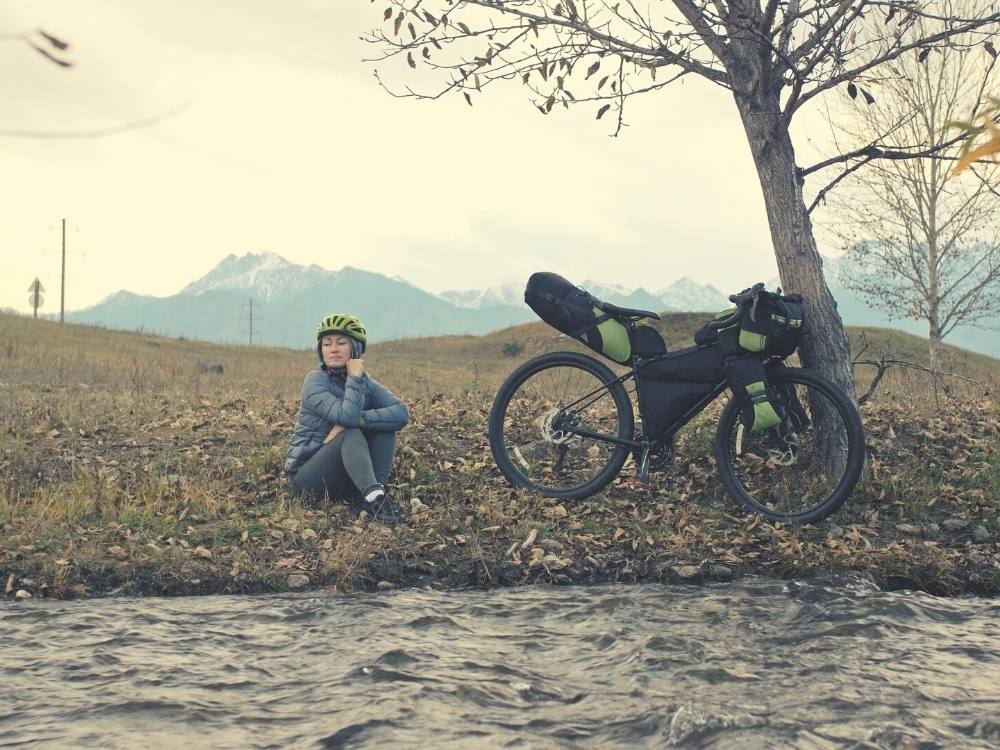
15+1 Best Bikepacking Bikes in 2024
Gravel, Touring, Plus, MTB Hardtail, Fat, Full-suspension, folding bikes & refurbishing a vintage bicycle for bikepacking
Let’s talk bikepacking bikes. Is there something such as the best bikepacking bike? Of course not, bikepacking trips can be very different and ideally require different bicycles.
Disclosure: Some of our articles contain affiliate links. This comes at no additional cost for you and helps us keep this website up and running. (as Amazon Associates we earn commission from qualifying purchases)
How we compile our gear guides: during the almost 10 years of cycloscope.net our team personally tested dozens of similar pieces of gear. For what we can't test personally, we involve other people in the cycling community to give their feedback and opinion about gear they have used. Our decade-long experience in bicycle touring enables us to find the key cons and pros of every product we mention.

Short but extreme bike-camping overnighters are better done on hardtails or even full-suspension MTB, while gravel bikes are super-sweet for fast mixed surface bikepacking journeys and ultra-cycling.
If you plan on an extended trip, the perfect bikepacking bike could be a traditional touring bike, or maybe a plus-size rigid… what about bikepacking on a folding bike?
In this article, we’ll go through all these categories of bikepacking bikes and suggest our favorite rigs for this year.
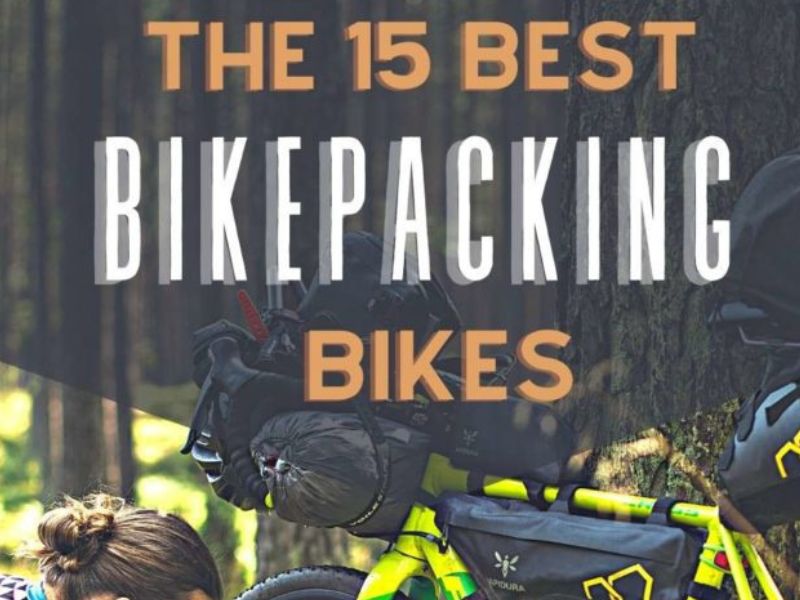
What’s The Best Bikepacking Bike?
Here we are going to analyse what kind of bikepacking each type of bicycle is suited for, and pick our best bikepacking bikes for each category.
7 types of bikepacking bikes
& our favorites in each category
- Gravel bikepacking bikes
- Cannondale Topstone Alloy
- Wilier Jena
- Trek Checkpoint
- Kona Rove LTD
- Specialized Diverge E5
- Touring bikepacking bikes
- Kona Sutra LTD
- Trek 1120
- Specialized Sequoia Elite
- Plus bikepacking bikes
- Bombtrack Beyond
- Salsa Fargo
- Ribble Adventure 725
- Fat Bikes for bikepacking
- Surly Pugsley
- Hardtail MTB bikepacking bikes
- Salsa Timberjack
- Full-Suspension MTB for bikepacking
- Kona Hei Hei
- Folding Bikes
- Tern Verge X11
5 Best Gravel Bikes for Bikepacking
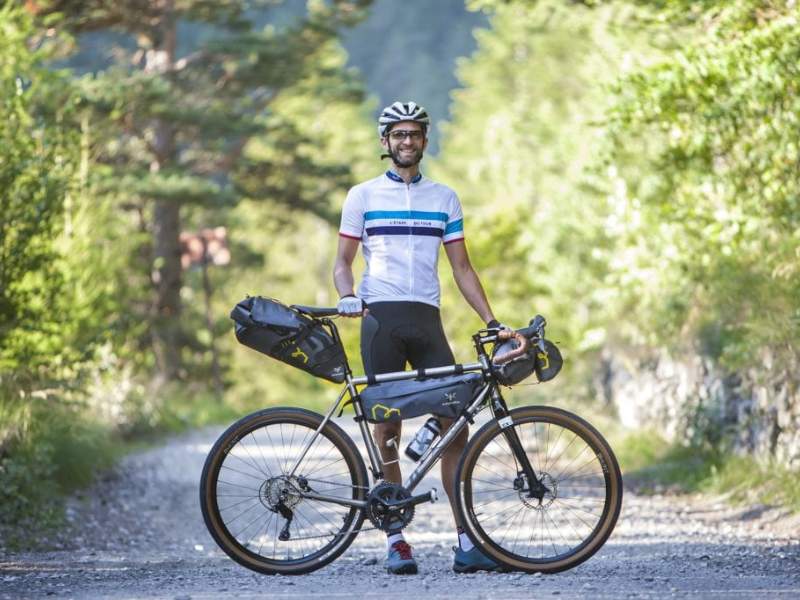
Gravel bikes are becoming the staple of ultralight bikepacking. They are an agile alternative to tourers and plus can handle center-weighted loads and a certain variety of non-extreme surfaces.
So, are gravel bikes good for any bikepacking trip?
Well, not exactly. Gravel bikes suffer on hard trails with steep gradients and uneven surfaces, they are not suited for sand and mud and have a limited set of gears (although this can be upgraded).
We wrote a whole post about the topic, called Gravel Bike Touring – The Why and the 6 best gravels for touring, check it out to know everything about gravel+travel.
Characteristics of Gravel Bikes
- Road inspired
- Disk brakes
- eyelets and mounting points
- Longer chainstay
- Compact gearing
Gravel bikes are great for ultra-cycling and fast-paced bikepacking trips on forgiving surfaces
Check also
> 11 best gravel bikes under 1,000/1,500$
Our favourite Gravel Bikepacking Bikes:
1. Cannondale Topstone Alloy [+/- $1,500]
best affordable bikepacking bike
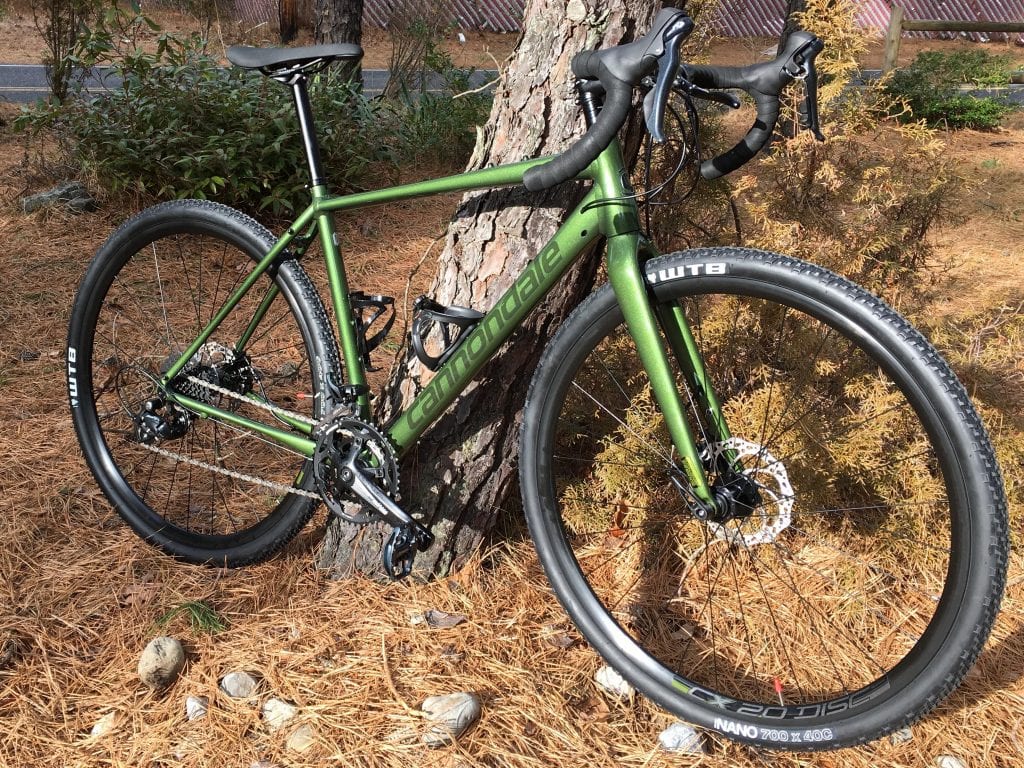
The Cannondale Topstone is a highly versatile bicycle that sits firmly in the gravel category.
Since it’s designed to be the ultimate combination of road racing and cyclocross bicycles, it can be considered a mixed-surface tourer as well as a 4 seasons commute bike.
At any time, with only a few adjustments, you can set up your rig for a camping bike trip, or join the group of your roadie friends.
The big tire clearance allows plenty of room for tires up to 42mm wide for comfortable grip and adventurous capability.
Although the front fork does not support any eyelets for cages on either side, it is a beautiful piece of carbon fiber, with a longer-than-usual rake (55mm) for stability and hidden full-fender mounts. It is a light and performing fork, rare on a bike at this price range.
With mounts for three water bottles plus mounts for top tube storage Topstone is ready to go long. Multiple bottle cage positions on the downtube mount let you configure for big frame bags.
Read our Cannondale Topstone Sora Full Review
| max tire clearance | 700c x 45mm/1.77″ |
| gearing | 46/30 x 11-34, 9-speed |
| weight | 10.3 kg (size M) |
2. Wilier Jena [+/- $5,500]
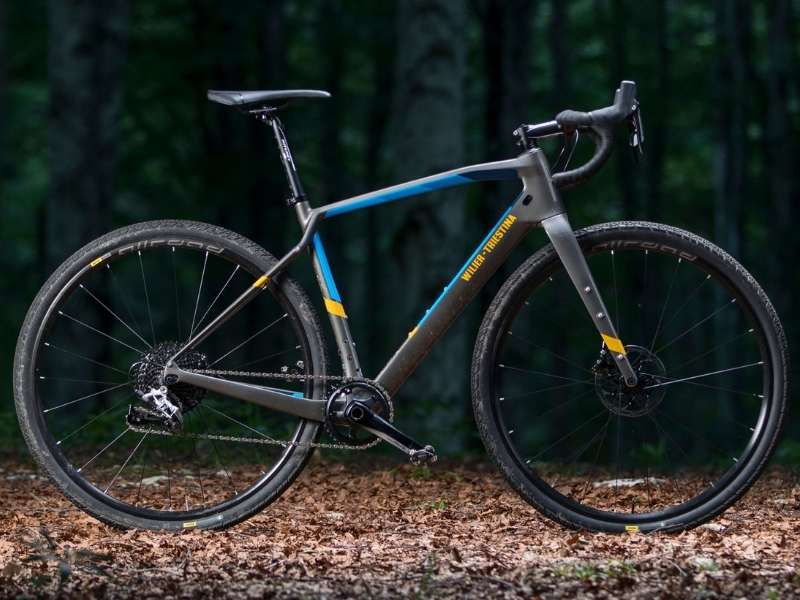
This 700c carbon bikepacking bike is the rig Omar di Felice used for his Winter Artic World Tour, this should say a lot already.
The Jena by Wilier is an ultra-versatile gravel bike, fast on tarmac, controllable on dirt, reliable on a single track, and can even challenge snow thanks to the long wheelbase and tire clearance of 44mm, pretty cool for a gravel bike.
The 2022 version mounts all SRAM components, with a standard gearing of 38t x 11-42t.
The Wilier Jena is an ultralight bikepacking bike with plenty of mounts and room for luggage, bottles, and fenders, the price tag though is quite steep.
| max tire clearance | 700c x 44mm |
| gearing | 38t x 11-42t |
| weight | 9kg/20lbs (size M) |
3. Trek Checkpoint [from $3,000]

The Trek Checkpoint has been completely redesigned for 2024 and it’s a hell of a bikepacking racer.
The stack/reach ratio is now 1.48 compared to the 1.42 of the previous model, offering an upright position that will ease fatigue on your lower back on long bikepacking rides.
Also, the chainstay has been lengthened by 10mm getting to an overall wheelbase of 105mm for the M size. All this makes the Checkpoint a very stable and well-balanced bike for gravel bikepacking.
The 500 Series OCLV Carbon frame with damped Rear IsoSpeed and carbon armor is state of the art. The IsoSpeed decoupler controls rebound by absorbing impact on bumps – your back, again, will be grateful.
A built-in storage compartment is a nice addition that allows you to stow basic tools inside the downtube. The internal cable routing only controls the brake, as the 1×12 SRAM Rival eTap AXS wireless electronic drivetrain is standard in all carbon versions.
Prices start from $2,400 USD for the alloy model and $3,000 for the carbon frame and fork.
| max tire clearance | 700c x 45mm |
| gearing | 46-30t x 11-34t – 24 speed |
| weight | 9.75 kg/22 lbs (size M) |
4. Kona Rove LTD [from $2,000]
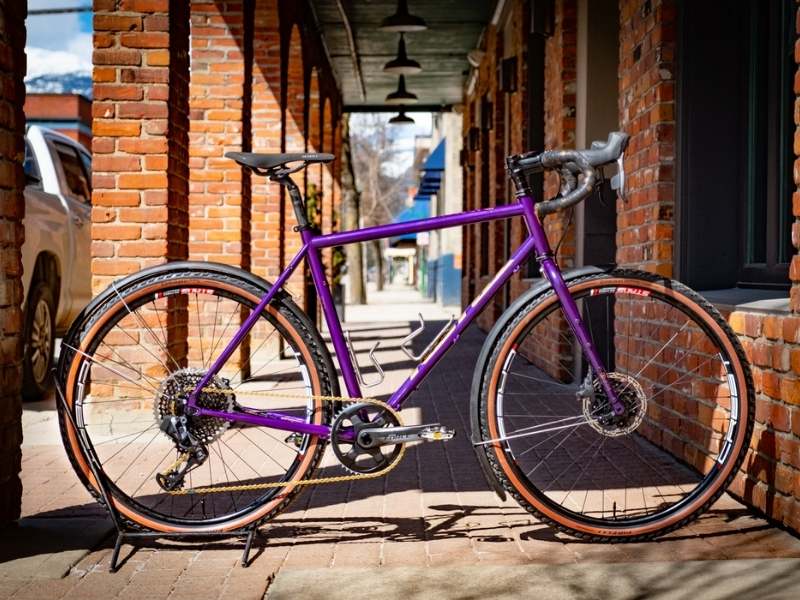
The Rove is a popular bikepacking bike available in 650b and 700c versions, in aluminum or steel frame and fork.
As it often happens with Kona products, the Rove has become the go-to bike for a plethora of bikepackers all around the world – and of course, there’s a reason.
A bike made for grinding miles over miles across mixed surfaces, it’s kind of a light version of the Sutra, a touring classic that we’ll feature below.
It has a slightly more aggressive riding position compared to the touring sister. With a 1.52 stack/reach ratio (pretty gravel standard), 61 trail, 435 chainstays, and 1,048 mm wheelbase.
While the declared tire clearance goes up to 48mm, it has been reported to fit up to 2.1″ tires.
| max tire clearance | 650b/700c x 48mm |
| gearing | 31-48t x 11-34t 22spd |
| weight | 11.1 kg (size M) |
5. Specialized Diverge E5 Gravel Bike [from 950$]
Best budget gravel bike for bikepacking Under 1000$
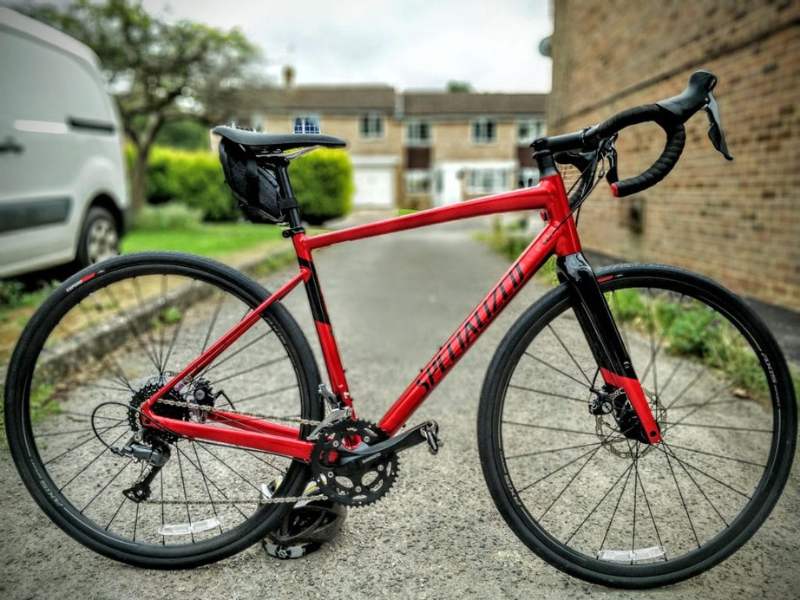
One of the most popular gravel bikes around, the Specialized Diverge is also one of the cheapest bikepacking bikes, you can get it for under 1,000$ if you go for the E5, mounting a Shimano Claris 8-speed groupset and Axis Sport Disc wheelset.
The Diverge by Specialized is a very sporty bike with a geometry slightly more compact than most competitors. It’s a responsive and agile bike that goes fast on the tarmac and grinds the gravel pretty smoothly, with a max tire clearance of 42mm, which is pretty standard on gravel bikes.
You can think of the Diverge’s geometry as a road version of a modern trail bike. It cuts corners and skids on dirt quite playfully but keeps stiffness up enough to satisfy your inner racer.
To achieve this, Specialized lowered the bottom bracket (over a half-centimeter lower than the previous Diverge), slacked out the head tube angle, and shortened the chainstays and the overall wheelbase.
The aluminum frameset and carbon fiber fork are high quality, but for its geometry and general building, the Diverge is certainly not a bike meant to carry heavy loads.
A cheap bikepacking bike for overnight adventures on mixed surface
| max tire clearance | 700x38c |
| gearing | 46/34T x 11-34t 8-speed |
| weight | 10.3 kg (size M) |
3 Best touring bikes for bikepacking
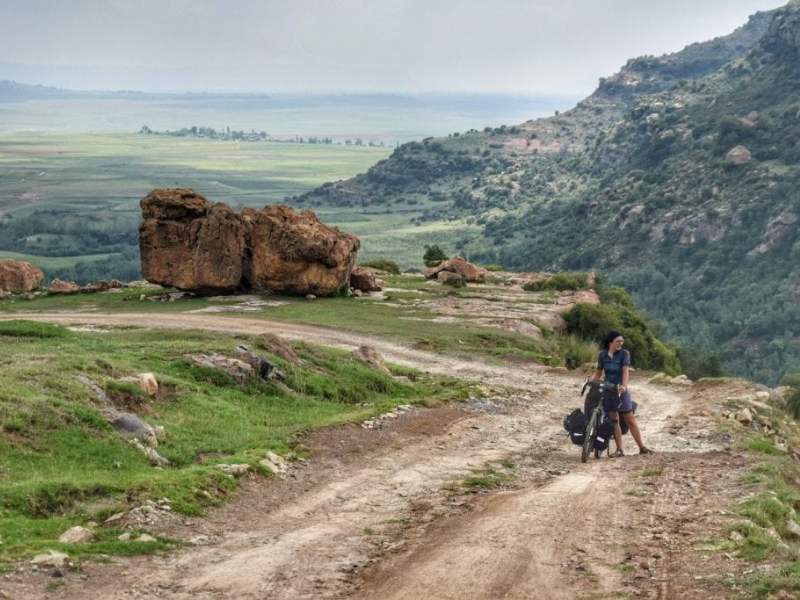
Touring bikes are meant for traveling long distances, they are sturdy and durable, comfortable, and easy to handle when heavily loaded.
Although different brands and models of touring bikes can feature different designs and materials (steel, aluminum, or even titanium), they have somehow similar characteristics, they are somehow a compromise.
Touring bikes handle pretty well a variety of terrains, without really excelling in any. They are heavy and sometimes a bit clumsy when ridden and unloaded.
Characteristics of touring bikes
- Long wheelbase
- long chainstay
- upright position
- perform best when heavy-loaded
Touring bikes are the best bikes for long-distance bikepacking expeditions
3 Best Plus Bikepacking Bikes
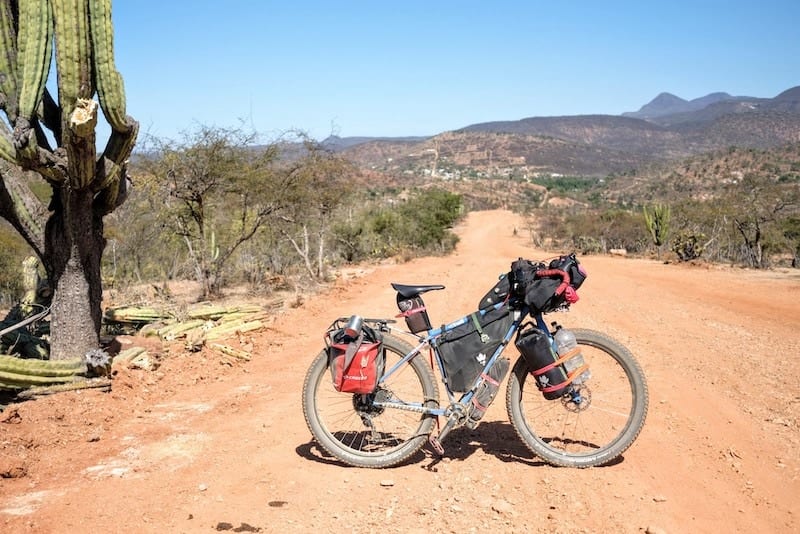
Plus bikes are kind of a novelty. Their main characteristics are a sloped geometry and more importantly a huge tire clearance, not quite like a fat bike but up to 3″ or more.
Plus bikes also often feature simplified gearing and transmission, often 1×11 or 2×10. They are somehow rigid-fork steel mountain bikes with drop bars (although a few flat bar options are around).
Plus bikes are meant to be adventure bikes and are really catered towards the bikepacking fanbase.
They perform at their best with bikepacking bags but it can also be loaded with lateral panniers and trunk bags. Touring vs bikepacking style, you can do both on a plus bike.
Characteristics of Plus Bikes
.wide tire clearance
.mountain bike geometry
.reduced gearing
Plus bikes are real adventure bikes, the ideal choice when touring for an extended period of time on difficult mountain roads
Check also
> Cinelli Hobootleg Geo
Our favorite Plus Bikepacking Bikes
1. Bombtrack Beyond – Touring Expedition Bicycle [+/- $1,800]
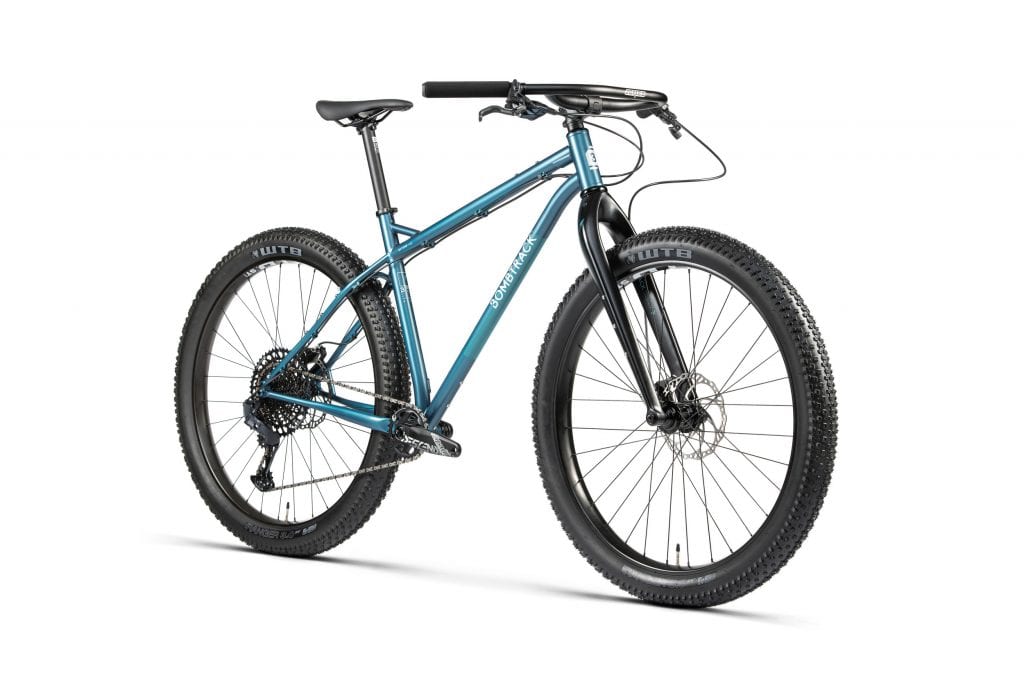
This expedition machine has been one of our favorites since it was introduced in 2016.
The Bombtrack Beyond features a single-speed chainring (30T) and a 12-speed 10-52T as the drive train of choice, a great set of gears capable of bringing you up the steepest and roughest hills. The carbon fork reduces the weight but still offers triple fork cage mounts.
Although Bombtrack still offers different handlebar options, the Jones Loop Bar will be the standard now. They might seem a little weird, but they offer more hand positions, helping the shoulders and upper body stay relaxed for hours in the saddle.
Designed as a bike packer’s dream, the Beyond features mounting options for front and rear racks as well as up to five water bottle cages.
The Bombtrack Beyond is just what I would use for extreme off-road bikepacking expeditions
| max tire clearance | 29” x 2.1” |
| gearing | 1 x 30 T / 12-speed, 10 – 52 T |
| weight | 12.9 kg (size M) |
2. Salsa Fargo Apex [+/- $2,500]
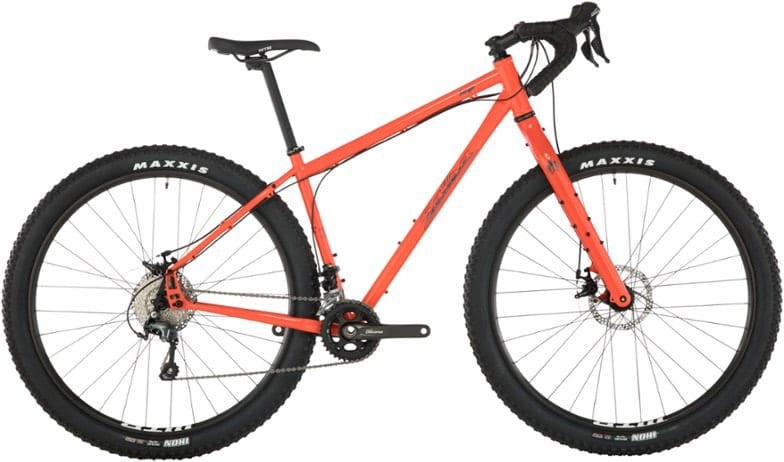
Salsa attacks frontally the bikepacking market with its latest version of the classic Fargo.
Far from the traditional geometries that characterized the Salsa Fargo in the past, since 20129 the Fargo has to meet or anticipate all the latest market trends for off-road touring: wide tires (up to 3.0″), small chainrings (36/26t) and big grannies in the back (10 speed 11-34), aggressive geometry, and carbon fork.
The new Salsa Fargo gives the rider a well-balanced mix of rollover, traction, and bump absorption.
The Firestarter 110 carbon fork, has a dual set of Three-Pack mounts on each fork leg, low rider rack mounts, and internal dynamo hub wire routing. Features the Salsa trademark Woodchipper handlebars.
An amazing off-road adventure machine – great for extreme bikepacking trips
| max tire clearance | 29” x 3.0” / max 58mm |
| gearing | 26-36t T / 12-speed, 10 – 52 T |
| weight | 11 kg / 24.5 lbs (size M) |
3. Ribble Adventure 725 [from $1,400]
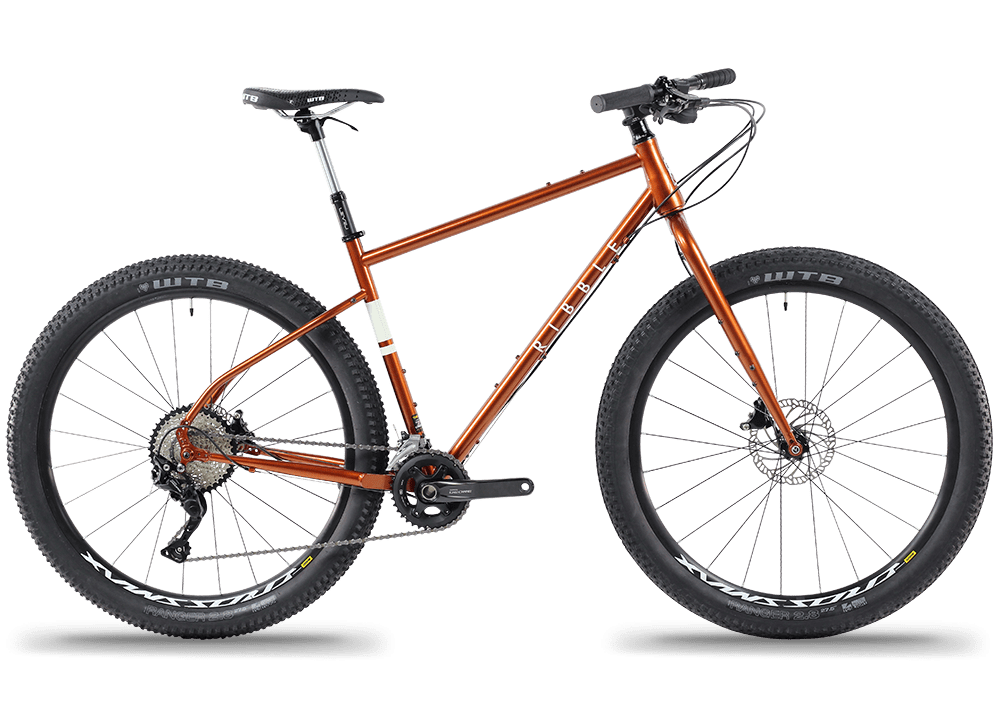
This is a very interesting and innovative bike, with amazing specs and a great price tag. The Adventure 725 by the British manufacturer Ribble Cycles (in business since 1897) features a weird-looking thin Reynolds 725 tubing with a very “contemporary geometry”.
Handcrafted from steel which is renowned for offering the most compliant of rides as well as being a highly durable material due to its high tensile strength, the carefully profiled tubing also results in the lateral stiffness not being compromised. This carefully thought-out geometry also offers the maximum balance between control and long-distance and mile-eating comfort (at least according to Ribble).
The mammoth tire clearance for tires up to 2.8” on its 27.5 wheels is absolutely great for those who want to venture on sandy tracks, this is one of the widest tire options in this list.
Added versatility is given by the several mounting points for racks (that can be doubled to use bikepacking cages), three bottle mounts, and fender mounts. The 11/42T 10-speed cassette gives a great granny gear that should be able to bring you up the steepest tracks.
The Ribble Adventure 725 is an innovative bikepacking bike, great for tackling extreme roads in comfort
| max tire clearance | 27.5” x 2.8” / max 56mm |
| gearing | 26-36t T / 11-42 T |
| weight | 12 kg / 26.6 lbs (size M) |
Fat Bikes for Bikepacking
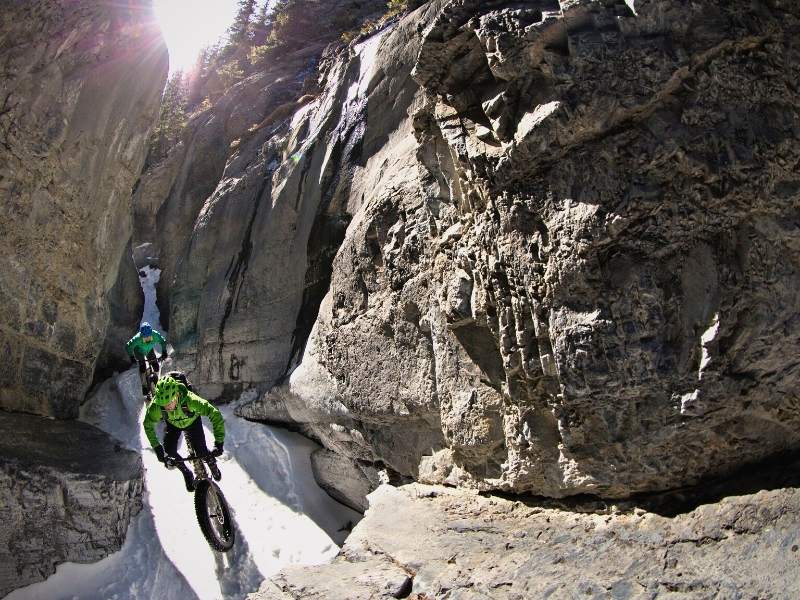
Fat bikes are exactly what they sound like, bikes with very fat tires – typically 3.8″ (97 mm) or even wider.
Fat bikes are meant to ride in all terrain conditions, including snow, ice, and thick sand. They are also quite heavy though, and replacement parts can be hard to source.
Characteristics of Fat Bikes
- Fat tires/All terrain
- Natural suspension
- MTB geometry
Fat bikes are meant for unique expeditions – if planning to ride across deserts, snowed mountains, or artic latitudes in winter a fat bike is what you want, otherwise… look elsewhere
Our favorite bikepacking fat bike
Surly Pugsley [+/- $1,900]
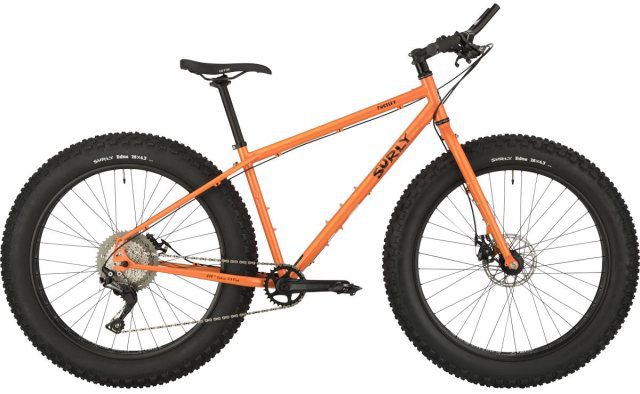
A bicycle specifically designed to handle sand and snow. Surly claims this bike is the “ultimate expedition bike tailored for off-road touring and exploration”.
The mammoth tire clearance of 26″ x 4.8″ tires in the back (with drivetrain restrictions) and 26″ x 4.3″ tires in the fork allows you to play with pressure and ride in comfort on almost any surface imaginable.
The rims are (80mm) dual hole pattern, Tubeless Ready rims custom made by Surly. Paired with Surly Edna, 26×4.3, 60 TPI, Tubeless Ready Tires they are a semi-invincible couple
The longer chain stay guarantees heel clearance for panniers, although a proper rack should be used, such as the Surly Nice rack.
All the eyelets you might need are brazed on the inside and outside of the frame. The fork is bikepacking cargo cage ready.
The Surly Moloko Bar offers a different variety of hand positions and space for electronics, which is what you want for extended bikepacking expeditions.
The gear is a 1X11 setup, with an 11/46 rear cog and a 30T chainring.
The Surly Pugsley is relatively affordable for a fat bike at just 1,900 USD.
| max tire clearance | 26″ x 4.8″ back / 26″ x 4.3″ front |
| gearing | 1X11 11/46 |
| weight | 15 kg (size M) |
Hardtail MTBs for Bikepacking
Hardtail MTBs are great for bikepacking and although not the best bikes for touring, some are better than others at handling multiple-day adventures.
Some aluminum Hardtail perform great even on month-long expeditions, and if you really wanna get lost in the trails, what’s better than a mountain bike?
Hardtail MTB nowadays would prefer to be loaded in a bikepacking style vs a lateral panniers setup, but a proper MTB designed for multi’day adventures shouldn’t have no problems handling two small rear panniers.
Check also
> Mountain Bike Touring – The MTB Set-Ups for Bikepacking & Cycle Camping
The best hardtail MTB for bikepacking (IMHO)
Salsa Timberjack
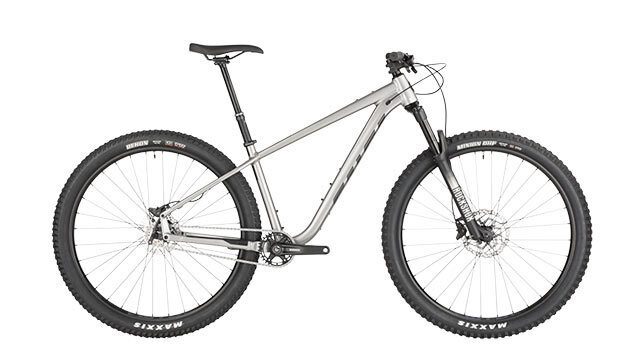
The Timberjack by Salsa is one of the most touring/bikepacking friendly harteil MTBs on the market.
Well-versed in singletrack and trail exploration, this rig also blinks an eye to the bikepackers out there with its many braze-ons mounting points and sturdy construction with 32-hole rims.
The geometry is comfy for a trail monster as this: a long top tube and wheelbase, low bottom bracket, slack head tube angle, and steep seat tube angle.
A complete build can be purchased for as low as $1,699.
| max tire clearance | 27.5 X 2.8” / 29 X 2.6″ |
| gearing | 32T x 12-Speed, 10-51T |
| weight | 13 kg (size M) |
Full Suspension MTB for Bikepacking
While hard tail are certainly more suited for traveling, full Suspension MTBs can still be used for extreme weekend bikepacking adventures. Frame bags for full suspension MTB are also manufactured.
Full suspension MTB bikepacking is actually becoming more and more popular, indeed frame bags for full suspension MTB are also manufactured.
Full-Suspension though, with their many moving parts, are sadly prone to failure. They are also quite hard to pack and don’t handle eccessive load – you’ll really have to go minimalistic when bike camping on a full-sus.
Our favorite full-suspension MTB for bikepacking
Kona Hei Hei
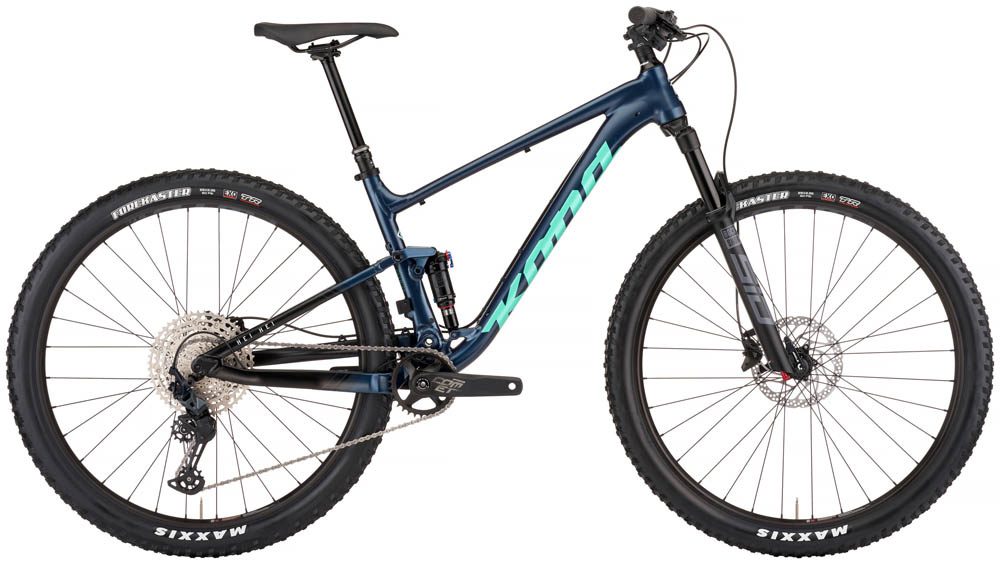
The Kona Hei Hei is a superb alloy full-suspension MTB that has proven itself bikepacking worthy.
It features a durable and lightweight Race Light Aluminium frame, a RockShox suspension fork, and hydraulic disc brakes.
Fork travel is 120mm in the front and 100mm rear, just right for bikepacking. The drive train is a Shimano Deore 1×12-speed group set with a 10-51T cassette.
This bike offers stable all-terrain control, smooth gear shifting, and powerful all-weather disc brake power.
Lightweight and Durable Cross Country Full-Suspension Trail Bike for Bikepacking
| max tire clearance | 29 x 2.5″ |
| gearing | 1 X 30T / 10-51T 12-Speed |
| weight | 11.8 kg (size M) |
Folding Bikepacking Bikes
Folding bikes make it easy to transport your rig when traveling – plane, taxi, train, buses… folding bikes can pack small and often be checked as regular luggage..
They also allow you to avoid boring or dangerous sections, since you can easily haul them onto a train or hitch a ride, saving your time to explore more interesting areas.
Folding bikes are also much more welcome in hotel rooms, where full size bikes are often banned or frowned upon, and even inside your camping tent if there’s a safety concern.
The main cons of folding bikes are their small wheels, innate fragility, and scarce parts availability.
Learn more about
> Folding bike touring & the 6 best foldable bikes for bikepacking
Folding bikes are the best travel bikes for those who want to bikepack across large distances in a limited amount of time
Our favourite folding bike for bikepacking
Tern Verge X11 – (+/- $2,500)
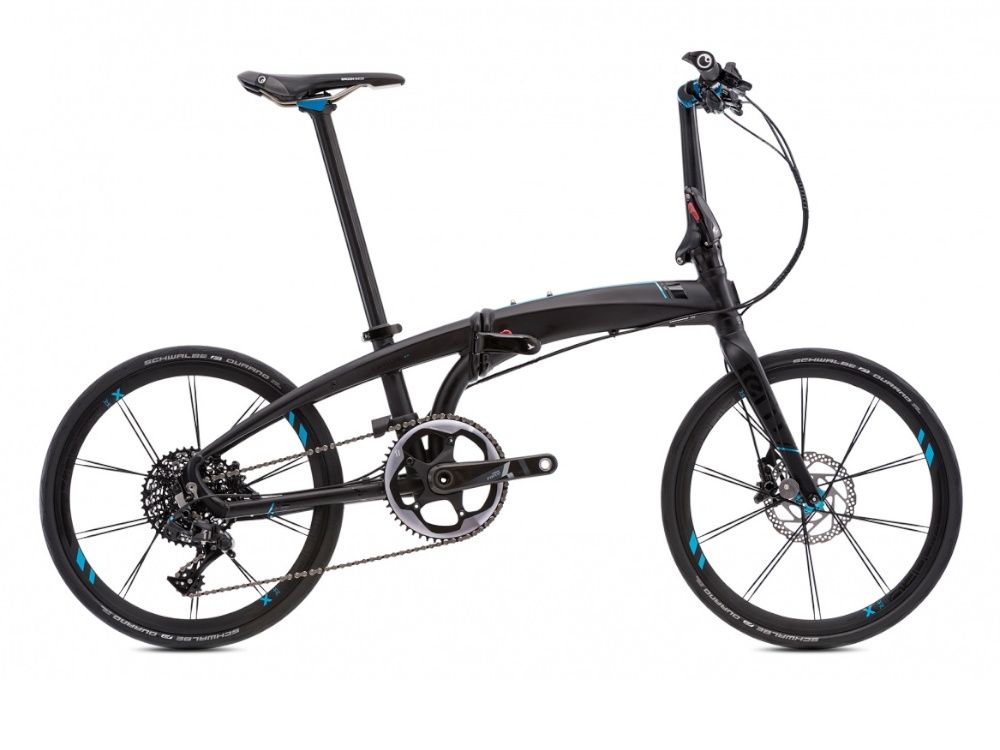
The Verge X11 is a very tantalizing folding bike. Super speedy, with a wide range of gears and a solid construction.
It comes with a large ratio cassette and SRAM Force 1x drivetrain. That means easy maintenance and gearing that will feel similar to a road bike.
With its 22″ wheels, it sets between a small-wheeled Brompton M6L and a large-wheeled Airnimal Joey.
You also get Kinetix Pro X wheels, Schwalbe Durano tires, and a durable adjustable stem.
The Verge X11 is a bit pricey at about 2,499 USD.
| max tire clearance | 700c x 45mm/1.77″ |
| gearing | 1×11 / SRAM X1 carbon 52T x 10-42T |
| weight | 10.2kg |
Refurbishing a vintage bike for bikepacking
Old MTBs from the 80s and 90s have been repurposed for touring since they exist, carrying thousand of budget adventurers around the world in the most remote places of our beautiful Earth.
Bikepacking is not just for those with a decent bank account and a powerful passport.
Although there is no doubt that, as a rule of thumb, you get what you pay for, I like to say that every bike is a bikepacking bike, as long as you put on some bags and go explore.
In this article we wrote extensively about
how to turn a free or cheap piece of junk into your next touring bicycle
Check Also
> Cheap Bikes! The Best Budget Bicycles in All Categories
FAQs About Bikepacking Bikes
What bikes are best for bikepacking?
- Cannondale Topstone Alloy
- Wilier Jena
- Trek Checkpoint
- Kona Rove LTD
- Specialized Diverge E5
- Kona Sutra LTD
- Trek 1120
- Specialized Sequoia Elite
- Bombtrack Beyond
- Salsa Fargo
- Ribble Adventure 725
- Surly Pugsley
- Salsa Timberjack
- Kona Hei Hei
- Tern Verge X11
Can any bike be used for bikepacking?
Basically any kind of bike can be uses for bikepacking if you manage to mount bikepacking bags on. The best types of bikes for bikepacking though are certainly: gravel bikes, touring bikes, fat bikes, plus bikes, Hardtail MTBs.
Are gravel bikes good for bikepacking?
Gravel bikes are becoming the staple of ultralight bikepacking. They are an agile alternative to tourers and plus that can handle center weighted loads and a certain variety of non-extreme surfaces.
So, are gravel bikes good for any bikepacking trip?
Well, not exactly. Gravel bikes suffer on hard trails with steep gradients and uneven surfaces, they are not suites for sand and mud and have a limited set of gears (although this can be upgraded).
Are Hardtails good for bikepacking?
Hardtail MTBs are great for bikepacking and although not the best bikes for touring, some are better than others at handling multiple days adventures.
Some aluminum Hardtail perform great even on month-long expeditions, and are literally the best bikes to get lost in the trails.
Hardtail MTB nowadays would prefer to be loaded in a bikepacking style vs a lateral panniers setup, but a proper MTB designed for multi-day adventures shouldn’t have no problems handling two small rear panniers.
Is a fat bike good for bikepacking?
Fat bikes are great for bikepacking! They can go really off-the-beaten-path across sand, snow, and rocky surfaces.
Can I use a hybrid bike for bikepacking?
Hybrid bikes usually have rear carriers so can be equipped with regular bike panniers. Of course there’s no problem in mounting bikepacking bags on a hybrid bike, step-through frames though don’t have space for frame bags.
Can you use a road bike for bikepacking?
Although most people often connect bikepacking with off-road cycling, bikepacking is really just a style of carrying load for multi-day bike trips. A road bike is perfect for ultralight bikepacking if you’ll be using only tarmac roads.
Do bikepacking bikes have suspension?
Suspensions can be useful on bikepacking bikes when used for off-road adventures. Some gravel bikes have other forms of suspension, either naturally provided by the geometry or using new tech such as IsoSpeed Decoupler.

